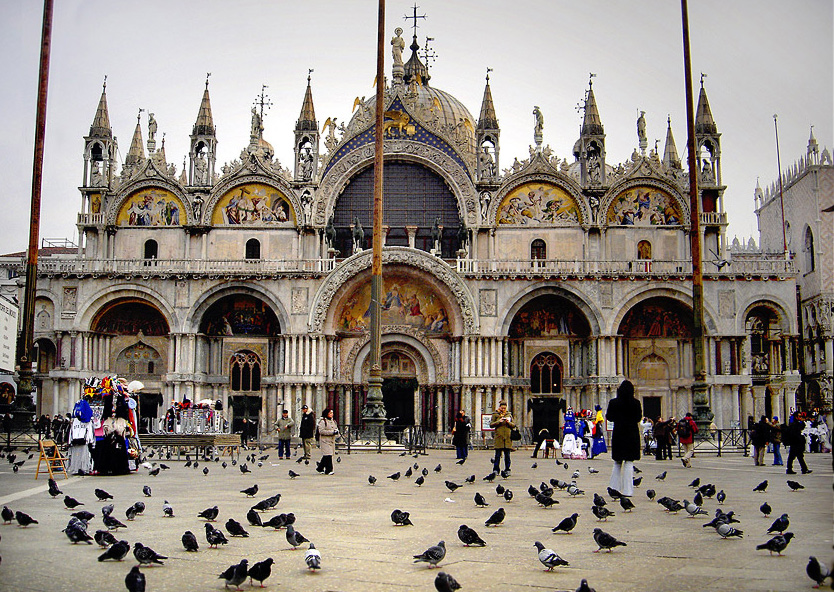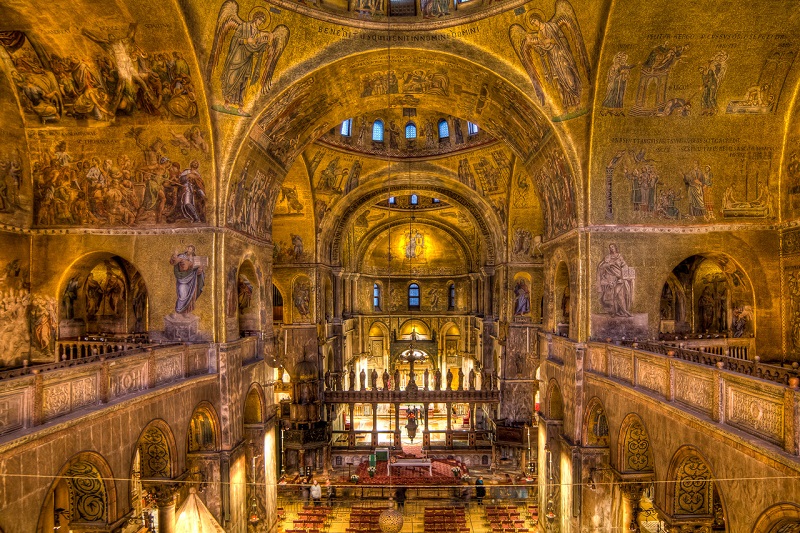Main author
Michael BrooksSt Marks Basilica
St. Mark’s Basilica is a Roman Catholic church in Piazza San Marco, Venice, northern Italy. It is one of the most recognisable churches in Italy and one of the best examples of Italo-Byzantine architecture. It is connected to the Doge’s Palace and the campanile.
The first church to be built on the site was ordered by the Doge in 828, to house the body of St. Mark. The present basilica was formed during redevelopment around 1063-1094 and was intended as the Doge’s Chapel. In 1807, it became the seat of the Patriarch of Venice.
The 11th century restoration made the basilica into a symbol of Venetian opulence and power, its elaborate decorations and gold ground mosaics resulting in the nickname ‘Church of gold’.
The architectural design of the basilica is celebrated for its articulate nature, with a basic structure that has not much altered since the 11th century. The central dome is supported through spandrels and large vaults on four pillars. The two arms of the Greek cross-shape are divided into a nave and two aisles. Each arm has a dome of its own as well as the main dome above the intersection.
The narthex and the new façade were constructed in the first half of the 13th century. Around this same time, most of the mosaics were completed and the domes were covered with secondary domes, positioned higher, and made of lead-covered timber to blend in better with the redesigned Gothic architecture of the Doge’s Palace.
The exterior of the basilica’s west façade is divided into lower register, upper register and domes. The lower register comprises five round-arched portals enveloped by polychrome marble columns.
The basilica contains more than 500 columns and capitals, most dating from between the 6th and 11th centuries. The 12th century marble floor is entirely tessellated in geometric patterns and designs of animals. The upper levels are decorated with bright mosaics covering an area of approximately 8,000 sq. m. Most of these mosaics incorporate gold glass tesserae which creates a shimmering effect.
[edit] Related articles on Designing Buildings Wiki
Featured articles and news
One of the most impressive Victorian architects. Book review.
RTPI leader to become new CIOB Chief Executive Officer
Dr Victoria Hills MRTPI, FICE to take over after Caroline Gumble’s departure.
Social and affordable housing, a long term plan for delivery
The “Delivering a Decade of Renewal for Social and Affordable Housing” strategy sets out future path.
A change to adoptive architecture
Effects of global weather warming on architectural detailing, material choice and human interaction.
The proposed publicly owned and backed subsidiary of Homes England, to facilitate new homes.
How big is the problem and what can we do to mitigate the effects?
Overheating guidance and tools for building designers
A number of cool guides to help with the heat.
The UK's Modern Industrial Strategy: A 10 year plan
Previous consultation criticism, current key elements and general support with some persisting reservations.
Building Safety Regulator reforms
New roles, new staff and a new fast track service pave the way for a single construction regulator.
Architectural Technologist CPDs and Communications
CIAT CPD… and how you can do it!
Cooling centres and cool spaces
Managing extreme heat in cities by directing the public to places for heat stress relief and water sources.
Winter gardens: A brief history and warm variations
Extending the season with glass in different forms and terms.
Restoring Great Yarmouth's Winter Gardens
Transforming one of the least sustainable constructions imaginable.
Construction Skills Mission Board launch sector drive
Newly formed government and industry collaboration set strategy for recruiting an additional 100,000 construction workers a year.
New Architects Code comes into effect in September 2025
ARB Architects Code of Conduct and Practice available with ongoing consultation regarding guidance.
Welsh Skills Body (Medr) launches ambitious plan
The new skills body brings together funding and regulation of tertiary education and research for the devolved nation.
Paul Gandy FCIOB announced as next CIOB President
Former Tilbury Douglas CEO takes helm.

























